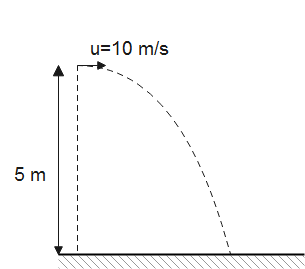
A ball of mass 1 kg is projected horizontally as shown in figure. Assume that the collision between the ball and ground is perfectly inelastic. Find the kinetic energy of the ball (in joules) just after collision.


Answer
553.5k+ views
Hint: Inelastic collisions are the collisions in which the objects colliding stick together with each other after collision. When the ball collides with ground its vertical velocity becomes zero due to impulse force acting on it. The horizontal velocity of the ball remains the same as it was just before colliding. The relation of kinetic energy and speed can be used to determine the kinetic energy of the ball.
Formula used: Kinetic energy, $K=\dfrac{1}{2}m{{v}^{2}}$
Complete answer:
When the ball is projected, it possesses some mechanical energy given by sum of kinetic and potential energy. Kinetic energy possessed by the ball is
$K=\dfrac{1}{2}m{{v}^{2}}=\dfrac{1}{2}\times 1\times {{10}^{2}}=50J$
Potential energy possessed by the ball as a virtue of its height is
$U=mgh=1\times 10\times 5=50J$
The total energy possessed by the ball initially is
$E=K+U=50+50=100J$
Just before colliding the ground the potential energy of the ball is converted to kinetic energy. In other words, due to vertical acceleration due to gravity, the ball gains some vertical velocity. But just after the collision, as the collision is perfectly elastic, the velocity perpendicular to ground is lost. Though the velocity of the ball along the ground remains intact. The velocity along the ground is the same as the velocity it was projected as no force is acting in a horizontal direction.


Therefore, the kinetic energy of the ball (in joules) just after collision is
$K'=\dfrac{1}{2}m{{v}^{2}}=50J$
Kinetic energy of the ball after collision with the ground is the same as the kinetic energy of the ball when it was projected.
Note:
Inelastic collisions are those collisions in which the objects colliding stick together with each other after collision. The law of conservation of momentum is valid for inelastic collisions. However, kinetic energy of the system may not remain constant.
Formula used: Kinetic energy, $K=\dfrac{1}{2}m{{v}^{2}}$
Complete answer:
When the ball is projected, it possesses some mechanical energy given by sum of kinetic and potential energy. Kinetic energy possessed by the ball is
$K=\dfrac{1}{2}m{{v}^{2}}=\dfrac{1}{2}\times 1\times {{10}^{2}}=50J$
Potential energy possessed by the ball as a virtue of its height is
$U=mgh=1\times 10\times 5=50J$
The total energy possessed by the ball initially is
$E=K+U=50+50=100J$
Just before colliding the ground the potential energy of the ball is converted to kinetic energy. In other words, due to vertical acceleration due to gravity, the ball gains some vertical velocity. But just after the collision, as the collision is perfectly elastic, the velocity perpendicular to ground is lost. Though the velocity of the ball along the ground remains intact. The velocity along the ground is the same as the velocity it was projected as no force is acting in a horizontal direction.


Therefore, the kinetic energy of the ball (in joules) just after collision is
$K'=\dfrac{1}{2}m{{v}^{2}}=50J$
Kinetic energy of the ball after collision with the ground is the same as the kinetic energy of the ball when it was projected.
Note:
Inelastic collisions are those collisions in which the objects colliding stick together with each other after collision. The law of conservation of momentum is valid for inelastic collisions. However, kinetic energy of the system may not remain constant.
Recently Updated Pages
Why are manures considered better than fertilizers class 11 biology CBSE

Find the coordinates of the midpoint of the line segment class 11 maths CBSE

Distinguish between static friction limiting friction class 11 physics CBSE

The Chairman of the constituent Assembly was A Jawaharlal class 11 social science CBSE

The first National Commission on Labour NCL submitted class 11 social science CBSE

Number of all subshell of n + l 7 is A 4 B 5 C 6 D class 11 chemistry CBSE

Trending doubts
What is meant by exothermic and endothermic reactions class 11 chemistry CBSE

10 examples of friction in our daily life

One Metric ton is equal to kg A 10000 B 1000 C 100 class 11 physics CBSE

1 Quintal is equal to a 110 kg b 10 kg c 100kg d 1000 class 11 physics CBSE

Difference Between Prokaryotic Cells and Eukaryotic Cells

What are Quantum numbers Explain the quantum number class 11 chemistry CBSE




